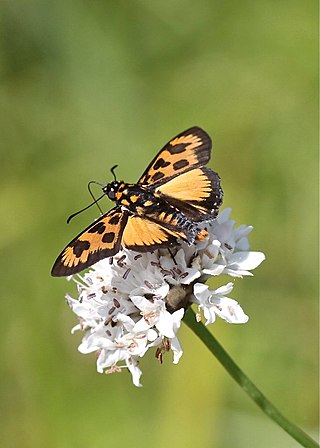
Betasuchus is a genus of theropod dinosaur which lived during the Late Cretaceous Period. Betasuchus is, besides Orthomerus, the only dinosaur genus named from remains found in the Netherlands and the only non-avian theropod found in the Maastrichtian Beds.

Pieter Willem Korthals was a Dutch botanist. Korthals was the official botanist with the Dutch East India Service from 1831 to 1836. Among his many discoveries was the medicinal plant Kratom . Korthals wrote the first monograph on the tropical pitcher plants, "Over het geslacht Nepenthes", published in 1839.

Eresiomera is a genus of butterflies in the family Lycaenidae. It is sometimes treated as a synonym of Pseuderesia.

Liptena is a genus of butterflies in the family Lycaenidae. Liptena is endemic to the Afrotropics.

Pentila is a genus of butterflies, commonly called pentilas or buffs, in the family Lycaenidae. The species of this genus are endemic to the Afrotropics. For other butterflies called buffs, see genus Baliochila.

Abantis is an Afrotropical genus of skipper butterflies. They are also known as the paradise skippers. Their imagos are generally attractive with bold or colourful wing and/or body markings. They occur in either forest or savanna, and several species are very localized or thinly distributed. The territorial males are encountered more often than the females. Males engage territorial intruders, and are prone to very rapid and high flight, while females display more relaxed flight habits, closer to the ground. Plants of several families serve as food plants, and only one egg is oviposited per plant. The larva is pale and spotted to varying degrees, and pupates inside a leaf shelter drawn together by silk threads.
Acada is an Afrotropical genus of skippers.

Osmodes is an Afrotropical genus of grass skipper butterflies in the family Hesperiidae.
Pardaleodes is a genus of skipper butterflies in the family Hesperiidae.

Sarangesa is a genus of skippers in the family Hesperiidae. Most of the species in the genus are found in the Afrotropical realm, while a few are in the Indomalayan realm.

Teniorhinus is a genus of skippers in the family Hesperiidae.

Xanthodisca is a genus of skippers in the family Hesperiidae.

The Erionotini are a tribe of skipper butterflies in the subfamily Hesperiinae.
Paronymus budonga is a butterfly in the family Hesperiidae. It is found in western Uganda and north-western Tanzania. The habitat consists of forests.

Paronymus nevea, the scarce largest dart, is a butterfly in the family Hesperiidae. The species was first described by Hamilton Herbert Druce in 1910. It is found in Guinea, Ghana, Nigeria, Cameroon, the Central African Republic, the eastern part of the Democratic Republic of the Congo and north-western Zambia. The habitat consists of primary forests.

Paronymus xanthias, the yellow largest dart, is a butterfly in the family Hesperiidae. It is found in Guinea, Sierra Leone, Ivory Coast, Ghana, Nigeria, Cameroon, Gabon, the Republic of the Congo, the Central African Republic, the Democratic Republic of the Congo, Uganda, Tanzania and Zambia. The habitat consists of forests.












